高中英语_高三英语阅读理解专项讲评教学课件设计
- 格式:ppt
- 大小:585.50 KB
- 文档页数:24

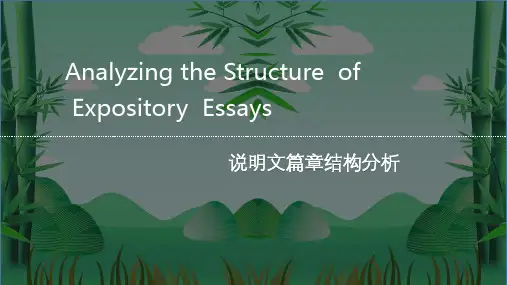
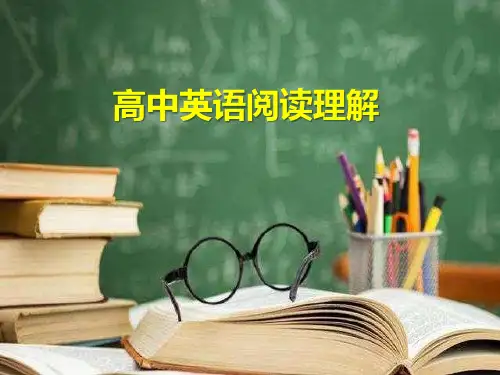
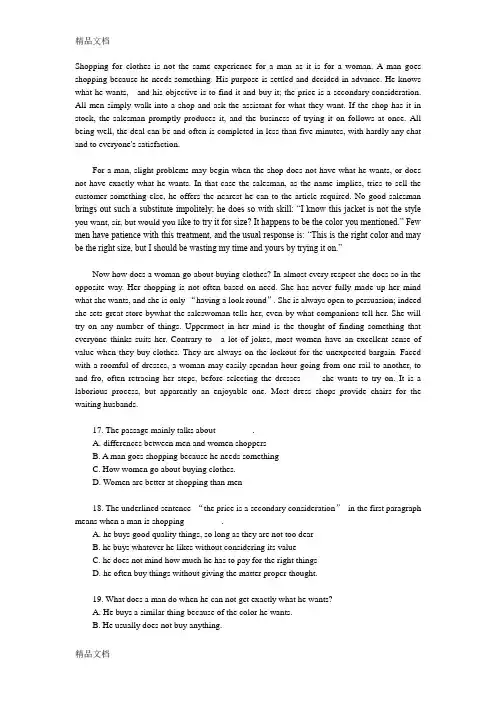
Shopping for clothes is not the same experience for a man as it is for a woman. A man goes shopping because he needs something. His purpose is settled and decided in advance. He knows what he wants, and his objective is to find it and buy it; the price is a secondary consideration. All men simply walk into a shop and ask the assistant for what they want. If the shop has it in stock, the salesman promptly produces it, and the business of trying it on follows at once. All being well, the deal can be and often is completed in less than five minutes, with hardly any chat and to everyone's satisfaction.For a man, slight problems may begin when the shop does not have what he wants, or does not have exactly what he wants. In that case the salesman, as the name implies, tries to sell the customer something else, he offers the nearest he can to the article required. No good salesman brings out such a substitute impolitely; he does so with skill: “I know this jacket is not the style you want, sir, but would you li ke to try it for size? It happens to be the color you mentioned.” Few men have patience with this treatment, and the usual response is: “This is the right color and may be the right size, but I should be wasting my time and yours by trying it on.”Now how does a woman go about buying clothes? In almost every respect she does so in the opposite way. Her shopping is not often based on need. She has never fully made up her mind what she wants, and she is only “having a look round”. She is always open to persuasion; indeed she sets great store bywhat the saleswoman tells her, even by what companions tell her. She will try on any number of things. Uppermost in her mind is the thought of finding something that everyone thinks suits her. Contrary to a lot of jokes, most women have an excellent sense of value when they buy clothes. They are always on the lockout for the unexpected bargain. Faced with a roomful of dresses, a woman may easily spendan hour going from one rail to another, to and fro, often retracing her steps, before selecting the dresses she wants to try on. It is a laborious process, but apparently an enjoyable one. Most dress shops provide chairs for the waiting husbands.17. The passage mainly talks about ________.A. differences between men and women shoppersB. A man goes shopping because he needs somethingC. How women go about buying clothes.D. Women are better at shopping than men18. The underlined sentence “the price is a secondary consideration”in the first paragraph means when a man is shopping ________.A. he buys good quality things, so long as they are not too dearB. he buys whatever he likes without considering its valueC. he does not mind how much he has to pay for the right thingsD. he often buy things without giving the matter proper thought.19. What does a man do when he can not get exactly what he wants?A. He buys a similar thing because of the color he wants.B. He usually does not buy anything.C. At least two of his requirements must be met before he buys.D. So long as the style is right, he buys the thing.20. What is the most obvious difference between men and women shoppers?A. Men do not try clothes on in a shop while women do.B. Women bargain for their clothes, but men do not.C. The time they take over buying clothes.D. Men go shopping based on need, but women never.答案与解析:17. A 主旨大意题。
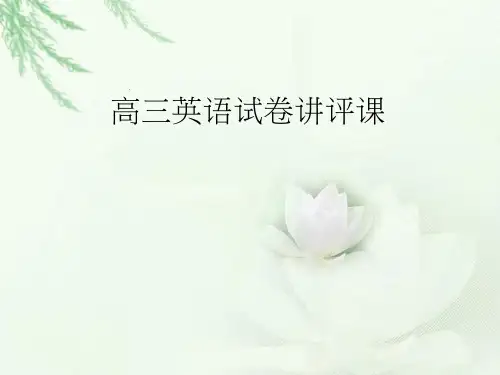
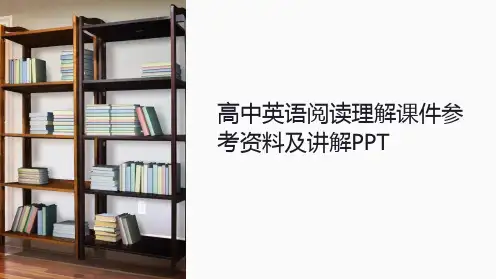
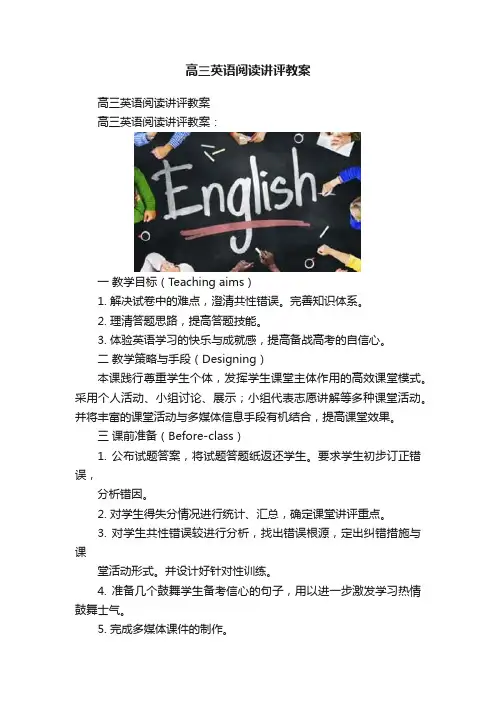
高三英语阅读讲评教案高三英语阅读讲评教案高三英语阅读讲评教案:一教学目标(Teaching aims)1. 解决试卷中的难点,澄清共性错误。
完善知识体系。
2. 理清答题思路,提高答题技能。
3. 体验英语学习的快乐与成就感,提高备战高考的自信心。
二教学策略与手段(Designing)本课践行尊重学生个体,发挥学生课堂主体作用的高效课堂模式。
采用个人活动、小组讨论、展示;小组代表志愿讲解等多种课堂活动。
并将丰富的课堂活动与多媒体信息手段有机结合,提高课堂效果。
三课前准备(Before-class)1. 公布试题答案,将试题答题纸返还学生。
要求学生初步订正错误,分析错因。
2. 对学生得失分情况进行统计、汇总,确定课堂讲评重点。
3. 对学生共性错误较进行分析,找出错误根源,定出纠错措施与课堂活动形式。
并设计好针对性训练。
4. 准备几个鼓舞学生备考信心的句子,用以进一步激发学习热情鼓舞士气。
5. 完成多媒体课件的制作。
四课堂实施(In-class)1. 作文范文背诵检查利用多媒体课件展示范文关键词辅助学生背诵。
本环节为全班集体活动(group work)。
2.介绍考试结果简要介绍学生试卷完成情况。
包括满分,最高分,优秀和及格人数。
3.明确教学目标与课堂内容(教师做简要说明)让学生明确这节课要做些什么,需要达成怎样的目标。
所有课堂设计与活动都是实现三维学习目标的措施与手段。
4.试题讲解A.单项选择(individual work)。
学生独立思考解决单项选择中正答率为70%以下的`题目(单选1.3.6.10)。
课件展示正答率、干扰项与考点。
独立思考2分钟后学生volunteer讲解题目。
有疑问的同学随时站起来质疑。
教师进一步点拨、总结。
然后当堂检测掌握情况,做巩固提升题(选取高考真题及2014高考预测)。
B.完形填空A篇(individual work)。
大声朗读完形A篇。
学生介绍文章大意,回答其他学生本篇题目中的疑问。

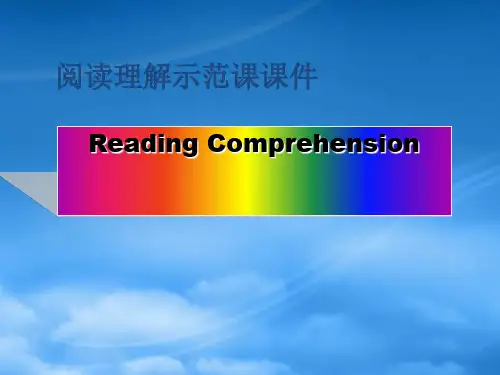
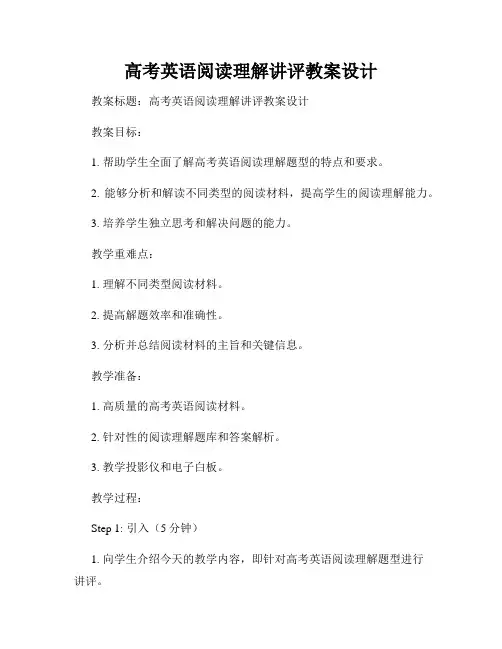
高考英语阅读理解讲评教案设计教案标题:高考英语阅读理解讲评教案设计教案目标:1. 帮助学生全面了解高考英语阅读理解题型的特点和要求。
2. 能够分析和解读不同类型的阅读材料,提高学生的阅读理解能力。
3. 培养学生独立思考和解决问题的能力。
教学重难点:1. 理解不同类型阅读材料。
2. 提高解题效率和准确性。
3. 分析并总结阅读材料的主旨和关键信息。
教学准备:1. 高质量的高考英语阅读材料。
2. 针对性的阅读理解题库和答案解析。
3. 教学投影仪和电子白板。
教学过程:Step 1: 引入(5分钟)1. 向学生介绍今天的教学内容,即针对高考英语阅读理解题型进行讲评。
2. 引起学生对阅读理解题型的兴趣,提出相关问题,激发学生思考和讨论。
Step 2: 分析不同类型的阅读理解题(15分钟)1. 分类介绍高考英语阅读理解题型的常见类型,如细节理解、推理判断、主旨大意等。
2. 分析每种题型的解题方法和技巧,引导学生理解和掌握解题思路。
Step 3: 解读高质量阅读材料(25分钟)1. 提供一篇高质量的高考英语阅读材料,并让学生阅读该篇材料。
2. 分步讲解材料中的难点和重点内容,帮助学生理解文章意思和抓住关键信息。
3. 引导学生进行详细解题分析,重点讲解解题过程和方法。
Step 4: 学生互动讨论和练习(20分钟)1. 小组讨论:将学生分成小组,让他们互相交流归纳出不同类型阅读理解题的解题技巧和方法。
2. 练习题:给学生分发相关阅读理解题目,让他们在小组内或个人完成,并进行梳理和解答。
3. 全班讨论:学生根据自己的答案,逐一讨论每个题目的解题思路和答案解析。
Step 5: 总结和反思(10分钟)1. 总结:总结今天的教学内容,强调学生应掌握的解题技巧和方法。
2. 反思:让学生进行反思和评价,提出问题和困惑,并给予解答和指导。
扩展活动:1. 给学生推荐相关英语阅读材料,鼓励他们进行阅读实践和自主学习。
2. 给学生布置相关阅读理解作业,提醒他们关注解题过程和方法。

阅读理解专项讲评教学案1.教学目标1)知识目标:学生能够掌握重要的词汇和句型。
2)能力目标:学生能划分出句子结构层次,理解长难句意思,掌握并灵活运用解题方法和技巧。
3)情感目标:增强学生的团队合作精神,互帮互助,共同提高。
2.教学内容:模拟试题一阅读理解部分3.教学方法:任务教学法4.教学过程Step1 IntroductionIntroduce students’ performance in this test.Step 2 Group Discussion and PresentationTask 1 Group DiscussionStudents work in groups of 4 to discuss and solve their problems.Task 2 PresentationGroup leaders explain each question in detail.1)细节理解题•22.terrified害怕的•23. can‘t help doing情不自禁做某事•presence存在,出现•32.the apple of one's eyes指极其宝贵重要的人或物;掌上明珠•You might think that being the apple of your mother’s eye could only be a good thing.•句子翻译:可能你会认为,被母亲看作掌上明珠是一件好事儿。
2)推理判断题•24.be regarded as把…看作…•donate 捐献•kidney肾•26. go through with…•=follow through with…•完成,把…进行到底•28.mobile 移动的•Dutch=Netherlands荷兰•popularity•social media 社交媒体•33.tension 紧张•favor 喜欢•context 背景•late 晚年的,末期的•35.previous以前的•carry out进行,执行•tend to do sth…倾向于…•be similar to 与…相似•in terms of从…角度而言3)主旨大意题•31.ban禁止•outnumber多于…4)词义猜测题•27.affirm确定,确认•hit it off(with sb)与…投缘•schedule安排•surgery手术Step 3 SummaryTeacher summarizes methods and skills in dealing with reading comprehension.1)细节理解题:2)推理判断题:3)主旨大意题:4)词义猜测题:Step 4 Limited ExercisesFinish two passages.Ⅰ.阅读理解A(2017年湖南十三校第一次联考)With fast food and convenience at our fingertips on every corner and at every turn, it is becoming increasingly hard to stay in shape.Staying healthy has been more and more difficult for many of the common people.To oppose this we would like to arm you with four ways of staying healthy and feeling great.You really are what you eat.It's true, and there's no way around it.You can't be sitting there staring at that plate of fried chicken, hoping that you will feel amazed later in the day.We have to be in reality about what we eat.If we are putting dead and fried food in our bellies, what is going to come out is exhausted energy and illness.Enjoy the sun.Enjoy the sunshine, or the wind or cold for that matter.In other words, get outside.Take a walk.Do it every single day.You don't have to be doing intense and heavy runs day in and day out, but you do need to be moving.You see, a healthy metabolism (新陈代谢) will only come from an active lifestyle.Those who have a sedentary living, sitting in office chairs or hardly moving,will have bodies adapted to that lifestyle.But if your body thinks that it needs to burn, then it will get in the habit of burning.Shop around the outside of the grocery store.This is becoming more and more of a popular saying among healthfood advocates.The inner passages are far more likely to be filled with preservatives(防腐剂) and chemicals to keep those boxed and packaged foods fresh for long periods of time.Yet eating fresh fruits, vegetables, unprocessed meats and so forth will keep nutrientdense foods going through your body.The more living items you consume, the more help they will be able to be to your immune system and your total body health.Water.Yes, simply and without end, water.You need this for every single function that your body performs.When you get up in the morning, before you put anything else on your tongue, drink a quart or two.Build up the amount you consume each day.An option for water instead of other pickmeups.Day by day your body will realize that you are going to be more thoroughly hydrating, and it will keep you feeling healthy as you can be.1.According to the author, what makes it difficult to keep healthy?A.People are too busy to take exercise.B.Our life becomes more and more convenient.C.People are used to living a lazy life.D.The stores are around our houses.2.When is the best time to drink water?A.After getting up in the morning.B.After finishing your lunch.C.Before going to bed.D.After breakfast.3.What is the best title for the passage?A.We are what we eatB.Tips for staying healthyC.It's better to shop aroundD.Water is very important for our bodyB(2017年衡水中学高二大联考)Scientists in Britain have managed to teach bumblebees (大黄蜂) to pull strings to get to food and then pass on what they havelearned to others in their colony (群体)—showing a high level of intelligence despite their tiny brains.Researchers at Queen Mary University of London said the experiments, often used to test the intelligence of apes (猿) and birds, showed for the first time that some insects are up to the task, and can also pass skills on through several generations.The findings add to the evidence suggesting the ability for “culture spread”—the ability to learn and pass on knowledge and skills—may not be exclusive to humans.In the research, published in the journal PLOS Biology on Tuesday, the scientists were able to train 23 out of a group of 40 bees to pull strings with their legs and feet.The strings were attached to discs—or artificial “flowers”—containing food at their center but placed under a transparent screen.The bees, spotting the food beneath the screen, learned to pull the “flowers”out by pulling the string with their legs and feet to be able to get to it.From another group of bees given the chance to solve the task without any training, only two of 110 were successful.Another group of bees was then allowed to observe the trained bees pulling the strings, and 60 percent of them successfully learned the skill.Finally, trained bees were put in colonies, and the scientists found the technique spread successfully to a majority of the colony's worker bees.Lars Chittka, a Queen Mary University professor who guided the project, said the team is interested in figuring out the brain processes behind the bees' learning and teaching skills.4.What does the underlined word “exclusive” in Paragraph 3 probably mean? A.Ordinary. B.Unique.C.Beneficial.D.Widespread.5.What did the researchers find about bees?A.Bees learn best in insects.B.Bees are as clever as birds.C.Bees are born good learners.D.Bees can be trained to learn skills.6.What may the research team focus on next?A.What else bees can do.B.Where bees learn skills.C.How bees teach others.D.How bees' brains work.7.What may be the best title for the text?A.Small Bees, Great AbilitiesB.Bees Can Learn and TeachC.Bees Are SmarterD.Let Bees LearnStep 5 Homework1)Make notes in time.2)Finish another two passages.学情分析本班是普通理科班,大部分学生的英语学习能力底子一般,其中以男生居多,他们平时不爱学英语,不喜欢背单词,针对这种情况,必须想办法调动他们的积极性。